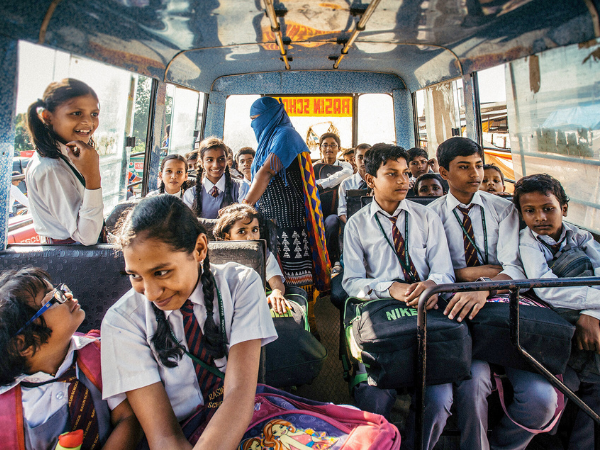When it comes to school buses, you might wonder how many seats are on each type. You may need to know this for planning field trips, organizing transportation, or simply satisfying your curiosity.
This guide we’ll break down the differences between standard and full-size school buses. You’ll discover how many seats each type typically has and what factors can influence these numbers.
Understanding School Bus Seating Capacities
The number of seats on a school bus affects how many students can travel together. It is important to know the difference between standard and full-size buses.
The Purpose Of School Bus Seating
Buses are designed to safely transport a large number of students to and from school. Proper seating ensures that every child has a designated place.
- Optimized for Efficiency: Seating arrangements maximize capacity while adhering to safety regulations.
- Varied Needs: Different bus sizes accommodate diverse student populations and route requirements.
Buses are built to meet strict safety standards, ensuring that each seat is secure. The design and arrangement of seating help protect children during transit.
Factors Defining “Standard” Vs. “Full-size”
Vehicle length and design play a crucial role in determining the number of seats. Typically, longer buses can accommodate more passengers.
- Vehicle Length & Design: Buses are categorized by size, which directly impacts the number of seats.
- Axle Configuration: Larger buses often have tandem rear axles to support increased weight.
- Gross Vehicle Weight Rating (GVWR): A key metric used to classify bus size and capacity potential.
Schools can evaluate their student population and select a bus size that meets safety and capacity requirements. Knowing the differences between bus types ensures efficient transportation for all students.

The Standard Full-size School Bus Seating
The standard full-size school bus is a familiar sight in communities. It plays an important role in transporting students to and from school. This section discusses the seating capacity of standard full-size school buses.
Typical 65-72 Passenger Capacity
The most common model of the traditional yellow school bus often seen on daily routes has a seating capacity of 65 to 72 passengers. This capacity is designed to accommodate a large number of students efficiently. The seating arrangement features rows of bench seats, typically accommodating 2-3 elementary students per bench.
- Bench Seating Design: Each bench is designed to hold a specific number of students based on typical body size.
- Child-Specific Rating: Capacity figures are usually based on an average elementary school-aged child.
- Federal & State Regulations: Safety standards dictate minimum seat width and aisle space per passenger.
- Weight Distribution: Seating capacity considers the safe distribution of student weight across the bus.
Here is a quick overview of the typical seating setup:
| Bus Model | Passenger Capacity | Rows of Seats |
|---|---|---|
| Standard Full-Size | 65-72 | 12 – 13 |
School districts often choose this type of bus for its high capacity. It meets the needs of large groups of students, especially in busy urban areas.
How Capacity Is Calculated
Calculating the capacity of a school bus involves several key factors. First, the seating arrangement plays a crucial role. Each bench seat is designed to hold a specific number of students. Typically, this is based on the average size of elementary school children.
Federal and state regulations also influence capacity calculations. These regulations establish minimum seat width and aisle space. The seat width must allow students to sit comfortably without overcrowding.
Here are the main factors in calculating capacity:
- Bench Size: Width and length of each bench impact how many students can sit.
- Aisle Space: Adequate space is needed for safe entry and exit.
- Weight Distribution: Proper distribution ensures safety during travel.
In summary, the calculation considers the safe and comfortable seating of students. This thoughtful design helps schools run their bus systems smoothly.

Smaller & Specialized School Bus Seating
Smaller and specialized school bus seating options cater to unique requirements. These buses focus on comfort, safety, and flexibility. They play a crucial role in transporting students with special needs or smaller groups.
Mini School Buses (Type A)
Mini school buses, also known as Type A buses, are designed for fewer passengers. They typically seat between 10 to 30 passengers. These buses are built on a van or cutaway chassis, which makes them resemble a large van.
Key features of Mini School Buses:
- Ideal for Shorter Routes: Used for special education or routes in tighter residential areas.
- Varied Capacity: Can range from 15 to 45 passengers or more, depending on the model.
- Comfort & Flexibility: Often have more comfortable seating and luggage space than traditional route buses.
These buses provide a safe and comfortable ride for students. They are easy to maneuver in narrow streets. Schools often use them for specific needs. They are perfect for smaller groups or short trips.
Activity/multi-function School Activity Buses (MFSAB)
Activity or Multi-Function School Activity Buses (MFSAB) are designed for various purposes. They do not have a stop-arm or flashing lights. They are not used for regular route service.
Characteristics of MFSAB:
- No Stop-Arm/Flashing Lights: Designed for activities like field trips and charter services.
- Comfort & Flexibility: More comfortable seating and luggage space available.
- Varied Capacity: Can accommodate different group sizes.
MFSABs are essential for school events and activities. They provide flexibility for schools to transport students safely. These buses can handle various needs, making them a popular choice for many districts.
Special Needs Buses
Special needs buses are crucial for students requiring extra assistance. These buses have reduced seating, with a capacity of 10-20 passengers. The lower capacity is due to specialized equipment.
Features of Special Needs Buses:
- Wheelchair Lifts & Tie-Downs: Feature ramps or lifts and securement systems for mobility devices.
- Customized Interiors: May include specialized harnesses or adaptive seating.
- Medical Equipment Areas: Provide space for essential medical gear.
These buses ensure safety and comfort for all passengers. They are designed to meet the specific needs of students with disabilities. Schools rely on these buses to provide equal access to education.
Factors Influencing Actual Seating Usage
Factors influencing actual seating usage play a crucial role. The age and size of students affect how many can fit comfortably. State and local regulations set the rules for capacity and safety.
Student Age And Size
Student age and size significantly impact how many can fit on a school bus. Younger children, like those in elementary school, take up less space. They are smaller and lighter, allowing more of them to sit on a bus. High school students, however, are usually larger. They require more room. This difference affects the overall capacity of the bus.
For example:
- More elementary students can typically fit on a bench than high school students.
- A “72-passenger” bus might carry 72 elementary students but only 48-50 high school students.
Seating arrangements are often adjusted for comfort and safety. Schools want to ensure that every student has enough space. This helps maintain discipline and safety during travel. The following table shows the differences in seating capacity:
| Bus Type | Elementary Capacity | High School Capacity |
|---|---|---|
| Standard Bus | 72 | 48-50 |
| Full-Size Bus | 90 | 60-65 |
State And Local Regulations
Each state may have specific rules regarding how many students can safely travel together. These regulations help ensure safety for all passengers. Varying requirements affect how buses are used in different areas.
For example:
- Some states have rules on seating density. This affects how many students fit on a bus.
- Seat belt mandates may also influence capacity. Buses equipped with three-point seat belts may slightly reduce capacity per bench.
- Most school buses do not allow standing passengers. This is for safety reasons.
Schools must follow these regulations. They often need to adjust their seating plans based on local laws. Understanding these factors helps schools maximize safety and comfort for all students.





Leave a Reply